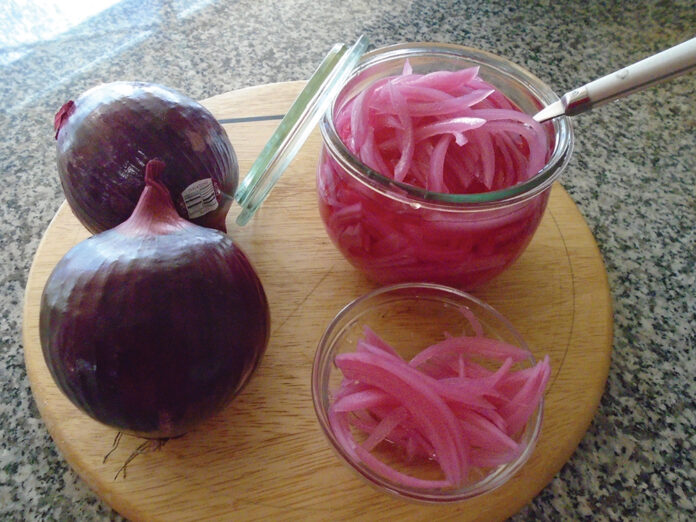I spent the last week in Palm Springs visiting friends, friends who no longer spend much time in their kitchen. Consequently, I was subjected to many restaurants.
Now I’m not complaining, but I did return home knowing that my French Onion soup far surpasses the one I had at a very posh restaurant.
Not enough caramelized onions, nor was the soup topped with my favorite Gruyere cheese on a sourdough baguette, with the cheese dripping down the sides of the bowl. Thin was its broth and a few croutons didn’t cut it. Nor did I detect any hint of a dry sherry wine gracing the soup. So disappointed was I that I decided that French onion soup will soon be on my menu.
It has been quoted among chefs that if you banish the onion from the kitchen, then the pleasure flees with it, and I, for one, cannot imagine cooking a dinner that doesn’t include onions.
As a child, I lived in Aberdeen, Washington along with my uncle and aunt, with backyard chickens and a large fruit and vegetable garden.
When aunt’s hands were busy in the kitchen cooking for our little family and six boarders who worked at the lumber mill next to our boarding house, she would call for me to go down into the garden and pull a few onions or pick whatever vegetable she needed at the time, a task I loved. However, getting there was a different story.
I needed to open the gate that led to our chickenyard and to the nasty Rhode Island Red Rooster who ‘ruled the roost.’ I remember running through that yard as fast as my little Buster Brown shoes would take me and fumbling for the latch on the gate that led to the vegetable garden. Once inside, I would slowly pull the beautiful spring onions from the soil, shake the soil from their roots and wash the remaining dirt under the backyard faucet before taking them into aunt.
Today, I use these spring onions, often called bunching or scallions, in deviled eggs, stir fry dishes, salsa and salads of all kinds. From the 21 varieties of onions, the yellow dry onions, seconded by the white, is the ‘workhorse’ in the kitchen. Red onions are best for salads and diced into salsas and often appear in Caesar salads and are great for pickling. This onion will turn a bluish color when cooked, not recommended for cooking.
Pearl or Boiling onions found in webbed bags of 15-20, are great for stews, creamed along with green peas or sautéed in meat juices.
Cipollini is a 2-inch round and flat Italian onion, and great for pickling or roasting. The cipollini is very rich and sweet in flavor, also found in webbed bags of 10 in the markets.
Scallions, also named spring, bunching or green onions, always have a band around them. They are peppery flavored and great in salads, salsas and dips. Delicious when thrown on the barbeque for a minute or two, along with steak or chicken.
Leeks, like their cousin scallions, are larger and milder and the main ingredient in Leek soup. More expensive and sold in bunches of two or three, only the whites are edible, or if sautéing, the very light green part of the stem can be used.
Chives, another tiny look-alike cousin to the Scallions, are a ‘little wonder’ that can be sprinkled on baked potatoes, deviled eggs or omelets, and soups or sauces. When used in a salad, they give a little kick to the dish.
Spanish onions are best used for fried Onion Rings as they have a much less water content than their relatives. Mild and sweet, they are often used in salsas.
Shallots are related to the onion family, although milder in flavor. Shallots grow in clusters of 3-5 much like garlic cloves. Great in salad dressings and sauces where a milder flavor is needed.
If you like pickled vegetables such as beets or asparagus spears, I am adding my recipe for pickled red onions which takes but a few minutes to make, and only a few days to be edible. Crisp and delicious, their color is beautiful.
I use the pickled onions in salads and as garnishes to a tray of appetizers such as veggies with a dip, a charcuterie tray or hamburgers. Try them and I guarantee you will become addicted as I have.
Pickled Red Onions
Ingredients
- 3 large red onions
- 3 cups any water
- 3 cups white distilled vinegar
- 2 tsp. salt
Directions
- Sterilize two-quart jars with boiling water
- Slice onions stem to root (not horizontally) and ¼ in. thick
- Fill jars with onion slices
- Then, in a pot, add rest of ingredients
- Bring to a boil and pour into jars, completely covering onions
- Screw on lids and let cool
- When cool, refrigerate
- Wait seven days before eating
Colly Gruczelak, a Ben Lomond resident, loves people and loves to cook. Contact her at cz****@*****st.net.










